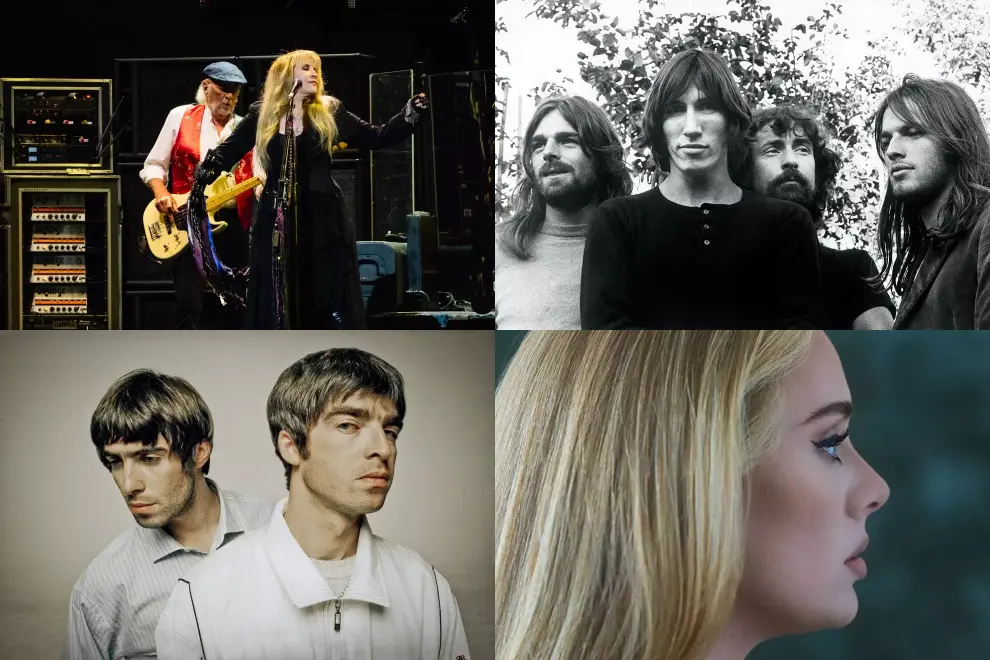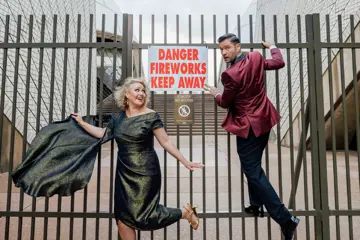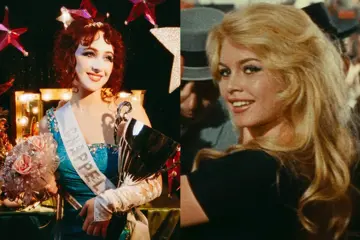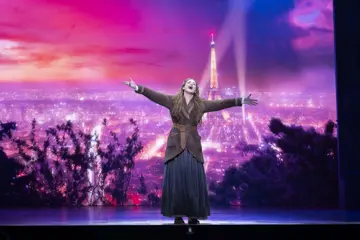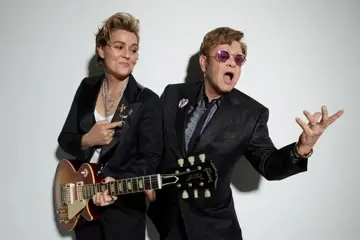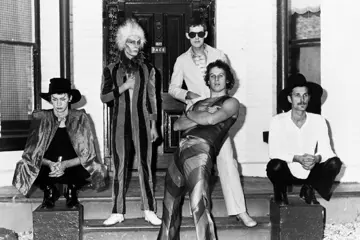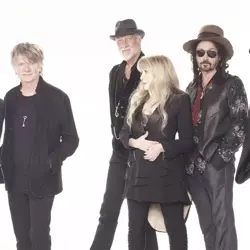 Fleetwood Mac
Fleetwood MacThe Australian Recording Industry Association (ARIA)’s decision to relegate albums over two years old to their own chart turned the spotlight onto albums that have remained on the charts for decades.
They have universality and timelessness that have original fans going back to buy them in new formats, and new generations embracing them for the same reasons. As a result, they bob back in and out of worldwide charts.
Most of the longest-running titles are hit sets. In Australia, INXS’ The Very Best was charting for 631 weeks. It was followed by Red Hot Chili Peppers’ Greatest Hits (565 weeks) and Fleetwood Mac’s The Very Best of Fleetwood Mac (534 weeks).
Cold Chisel’s The Best Of Cold Chisel: All For You was at 523 weeks, while Chisel’s more recent compilation, 50 Years, was at 59 weeks. Eminem’s Curtain Call: The Hits is at #32 this week, clicking over its 403rd week.
Don't miss a beat with our FREE daily newsletter
In the US, four of the six longest marathon runners are compilations, topped by Bob Marley & The Wailers’ Legend (892 weeks), Journey – Greatest Hits (862 weeks), Creedence Clearwater Revival’s 1976 Chronicle: The 20 Greatest Hits (751 weeks) and Eminem’s Curtain Call (741 weeks).
In the UK, ABBA’s Gold – Greatest Hits hit a milestone in March 2025 by becoming the first to hit the 1,200-week mark. That same week, it actually rose from Number 18 to Number 11.
Meanwhile, Greatest Hits by Queen is still generating heat, this month reaching 1,159 weeks in the band’s home country. It’s sold seven million there, 25 million worldwide. It’s expected to equal ABBA’s chart length achievement within months.
Here are six more game-changing albums that refuse to leave the charts—and the reasons why.
THE DARK SIDE OF THE MOON – PINK FLOYD (1973)
By June 2025, Pink Floyd’s The Dark Side Of The Moon had spent 1,000 weeks in the Billboard US chart, the longest stretch in that country by any record.
In fact, in April, it rose from Number 42 to Number 24 on the Top Album Sales (just physical, no streaming) and at Number 15 on the Vinyl charts.
Sales keep pressing the buzzer, as every decade sees a new deluxe reissue thrown up or the chance for fans to hear it through the latest technology. Last year in America, Record Store Day saw its sales up by 328 per cent, mostly on vinyl.
The Dark Side Of The Moon had, by January 2025, sold 58.8 million worldwide, according to TheWorldRanking.com. In Australia, it was certified 14 x platinum by ARIA for 1 million sales. International streams on Spotify are close to 3 billion, with daily sales at 1.3 million.
Under early leader Syd Barrett (trivia: the band was named after his two favourite US blues musicians, Pink Anderson and Floyd Council), Floyd were in the clouds on an endless LSD trip.
But by The Dark Side, bassist/songwriter Roger Waters said, “We wanted to come down to earth a bit. I had something I definitely wanted to say.”
It isn’t just the stunning production and playing – music for headphones – that keeps appealing to generations.
The low long heartbeat intro pulled 21st century teenagers and adolescents into an adult’s world of paranoia, money madness, us and them rivalry and breathing style survival they weren’t sure they wanted to be part of.
When Dark Side first came out, drummer Nick Mason attributed its runaway success to “When we finished it, we knew it was a great record. But it was also a record of its time.”
But decades later, as it remained in the sun, guitarist David Gilmour suggested to Q: “It still doesn’t sound dated. But I really don’t see why it should achieve that longevity over some of the other great records that have been out.”
LEGEND – BOB MARLEY & THE WAILERS (1984)
Legend is the only hits album on this list because Bob Marley has been more revered and popular since his death in May 1981 from cancer at the age of 36. He continues to break reggae’s reach more than any other.
The first international music superstar out of the Caribbean, he has the second-highest social media following of any posthumous celebrity. His official Facebook page has 70 million followers.
Legend remains the best-selling reggae album of all time. In the UK, with 4 million sales, it has spent 1,191 weeks in the top 100—the third-longest run in its history. In Australia, it was certified for 750,000 units. Over Europe, the figure is 2.1 million.
US sales are at 18 million and heading for 900 weeks in the Top 200. On Record Store Day 2025, sales jumped 17 per cent and entered four charts, including vinyl and reggae. Most in demand was the tri-colour (red, yellow, green) double 180g vinyl set.
In 1979, oozing with charisma and vision, Marley told Molly Meldrum on Countdown, “We describe our music as a route to consciousness. But we still regard it as music, revolutionary music. Revolutionary of the mind, bringing reality from the wise and the prudent.”
Released three years after his death, Legend is admittedly a “safe” collection of his tracks and meant for wide consumption.
But social justice anthems from the ‘70s such as No Woman No Cry, Buffalo Soldier, Get Up Stand Up I Shot the Sheriff, Exodus and Three Little Birds have new resonance.
Political and social movements from Australia to Zimbabwe to Nicaragua to New Zealand to First Americans – and Palestinian and Sri Lanka’s Tamil youth who took to arms – found Marley’s ability to articulate shared experiences of injustice both liberating and empowering.
The One Love movie and constant touring by The Wailers (back in Australia in spring) keep the message current.
21 – ADELE (2011)
As a teenager, even before she was signed, Adele Laurie Blue Adkins had the stee-lo take an emotional lyric and squeeze the skeet out of it.
Her debut album propelled her to global stardom, and you presumed the follow-up would be all happiness and achievement.
But a well-publicised marriage breakdown and a resultant struggle with anxiety and depression that left her bed-bound helped shape the narrative on 21.
“It knocked me for six when writing it,” she said on its arrival. “It’s different from 19, it’s about the same things but in a different light.
“I deal with things differently now. I’m more patient, more honest, more forgiving and more aware of my own flaws, habits and principles. Something that comes with age, I think. So, fittingly, this record is called 21.
“Every day, something happens that affects me, whether it be relationships, events, something I hear, something I see or something I feel. All of which is helping define me and turning me into who I’m becoming.”
21 was acclaimed as a musical masterpiece upon release, for moving the posts on what contemporary music should sound like, with emotive vocals and lyrics that pierced the heart.
She worked with renowned producers and songwriters like Rick Rubin, Paul Epworth and Ryan Tedder. Its mix of pop, blues, soul and country gave it wider appeal.
But as Adele explained, the music mix also stemmed from the new sounds and new artists she had discovered. These included the gospel of Wanda Jackson, the bluegrass country of Allison Krauss and The SteelDrivers, R&B soul of Yvonne Fair, swing folk of Andrew Bird, powerhouse indie-rock of Neko Case, and the country pop of Lady Antebellum.
“Then I delved into more from artists I’ve loved forever – Mary J Blige, Kanye West, Elbow, Mos Def, Alanis Morissette, Tom Waits and Sinead O’Connor.
“There’s something in every single one of these artists that has really, really inspired 21.”
The album has shifted over 54 million worldwide. She made about $15 million then, allowing her to splash out US$66 million for a Los Angeles mansion. It is attributed with catapulting the bank balance of its UK indie XL Recordings from £3 million (AU$6.27 million) to £32 million ($66.9 million) in a 12-month period.
In Australia, it was at Number One for 32 weeks, sprinting to become the seventh long-player to go over the million-selling mark (now 1.9 million). It pipped the 25-week stay at the top by John Farnham’s Whispering Jack and 29 weeks by Delta Goodrem’s Innocent Eyes. But it couldn’t dislodge the 35-week roll by Dire Straits’ Brothers In Arms.
On the week of February 27, 2024, the album marked its 600th week on the US charts, making her the first female artist to do so.
Importantly, alongside themes of heartbreak and anxiety were those of resilience and growth. Judging by the audience at her Australian shows, these struck a chord with women in their late teens or married. Fourteen years after 21’s release, they are passing the album on to their daughters or younger sisters.
DEFINITELY MAYBE – OASIS (1994)
"If we’re gonna get rid of Phil Collins and Sting – junk food music, McDonald’s music – we’ve got to get in the charts and stamp ‘em out.
"I want the severed head of Phil Collins in my fridge by the end of this decade. And if I haven’t, I’ll be a failure."
Right from the beginning, Noel Gallagher made it clear Oasis’s role was to be the dirt-around-the-collar disruptors. Belligerent if needed, confrontational, always peppered with dry North England humour.
It wasn’t just the famous sibling feuding, guitars bashed over heads backstage, or the singer missing the start of a US tour because he wanted to go house-hunting, or walking out of an interview because the journalist referred to their new album as “good” rather than “really great”.
During their Australian tour in 1998, Liam got a lifetime ban from Cathay Pacific after a food fight on board, and he copped two charges of assault, including a Brisbane fan who wanted a selfie.
The word Britpop was coined to describe their working-class devilry. For Noel, it was always the music. "We weren’t the best musicians, but we had spirit, man," he said in Oasis’ Supersonic documentary, "and that was lacking massively at that point."
Their out-of-the-gate success justified his stance. In a 2003 interview, he would reflect, "As soon as the first record came out, it was pretty much accepted. We were pretty accepted.”
By last September, Definitely Maybe had spent 556 weeks in the UK Top 100. After the reunion tour was confirmed, global streaming figures quadrupled, and Definitely Maybe went back to Number One in the UK.
The announcement also pushed the 2009 hits compilation Time Flies… (1994-2009) to the Number Two spot and the second album, (What’s The Story) Morning Glory, into the Top 5.
In the US, on-demand audio streams were 2.80 million on the day of the announcement, double that of the streams on the day before, when rumours were still flying about the get-back.
Also, whip-creaming interest was the release of a 30th anniversary deluxe version of Definitely Maybe, which included previously unreleased demos from the group’s original Monnow Valley and Sawmills Studios sessions across brand-new physical and digital formats.
Definitely Maybe only went Top 10 on original release, unlike (What’s The Story) Morning Glory? in Australia, which went to Number One.
Noel isn’t the least bit surprised that Definitely Maybe has been a stayer. He says Supersonic, Shakermaker, Live Forever and Cigarettes & Alcohol, all from 1994, were great singles.
"The songs are timeless," he suggested. "They deal with universal truths. Cigarettes & Alcohol applies to every young kid, even now."
THE SOUND OF MUSIC SOUNDTRACK (1965)
The gooey tale of a perennially uplifting wannabe nun, a grumpy navy captain and their yowling kids battling the surly Nazis was offset by some boss singalong-friendly songs from the kings of Broadway, Richard Rodgers and lyricist-dramatist Oscar Hammerstein II.
These included My Favourite Things, Do-Re-Mi, Sixteen Going on Seventeen, The Lonely Goatherd, Edelweiss and Climb Ev'ry Mountain.
When released in 1965, the movie starring Julie Andrews and Christopher Plummer was an instant ka-pow, going on to grab five Oscars.
Made for $8.2 million ($81.6 million today), it raked in $286.2 million worldwide ($2.85 billion) in its first four years, and US$82,248 (approx $836.8 million today) in Australia.
The soundtrack was in the Billboard US Top 10 for 109 weeks, and dropped out of the Top 200 after 238 weeks. But it has drifted in and out since, and in 2015, Billboard named it the second-best charting album of all time.
It went to Number One in Australia. It was the best-selling album in the UK in 1965, 1966 and 1968 and the second-best seller of the decade, spending a total of 70 weeks at the top spot there. All this, mind you, during Beatlemania and Motown Madness.
The latest sales estimates of The Sound of Music are 25 million worldwide, but it’s probably greater. In comparison, as of May 2022, the biggest-selling soundtrack was 1992’s The Bodyguard (the movie starred Whitney Houston and Kevin Costner) with 42 million worldwide.
The Sound of Music keeps having a burst of life with a CD in 1985 and now streaming. There were anniversary editions in 1995, 2000, 2005, 2010 and 2015.
In 2023, a 5-disc Super Deluxe Edition was released with the score in its entirety, with 42 unreleased tracks, including eleven alternate renditions, and songs dropped from the film. The end of the story for the soundtrack? We doubt it.
RUMOURS – FLEETWOOD MAC (1977)
In 2024, Fleetwood Mac’s Rumours passed 5 billion streams on Spotify. It remains the most-streamed album from the 1970s on the platform.
Just to underline what an achievement that was, ChartMasters noted that the most-streamed album from the 1960s was The Beatles’ Abbey Road with 3 billion streams. The two waving the flag for the 1980s, Michael Jackson’s Thriller and Guns N’ Roses’ Appetite For Destruction, were both streamed 4.5 billion each.
The singles are whipping it up too, as new generations discover them through movies, games and ads. Ten out of Rumours’ 12 tracks clicked over 100 million streams. Dreams is over 1.5 billion streams, The Chain over 1 billion and Go Your Own Way over 900 million.
Rumours has sold 66.9 million copies worldwide. Three years after its 1977 release, it had sold 10 million copies around the world. It won album of the year at the 1978 Grammys.
According to Luminate, it still sells 4,400 a week in America, where in the late 70s, it hung in at the top spot of the 200 for 31 non-consecutive weeks. In 2025, it was in the rock, rock & alternative charts, vinyl and streaming charts.
In Australia, it moved 975,000 by 2011 (when it was certified 13 x platinum), and it’s safe to say it’s hit the million mark by now. This week, it is still in the ARIA chart, at #21, after 404 weeks.
In 2011, it unexpectedly returned to Number 2, after Network Ten aired a Mac-themed episode of Glee. It had another crack in 2022 following Christine McVie’s passing that November.
As of November 2023, Rumours spent over 1,000 weeks in the top 100 of the UK Albums Chart, where it sold 4.2 million units. It still sells 32,500 copies on vinyl a year there.
So why are the under-20s finding the album and Mac cool again? It’s probably why fans in 1977 rushed at it. The songs are heavy with pan-generational hooks and top-class poly-rhythmic musicianship. Rumours was delayed repeatedly because the Mac wanted to get the perfect mix.
As is known, the album was made in the middle of turmoil in their personal and career relationships, and the anger, bitterness, betrayal, new beginnings and optimism in the songs struck a universal chord.
Stevie Nicks told Uncut in 2003, “Lindsey (Buckingham) and I were in total chaos a year before we met Fleetwood Mac. I had already moved out of our apartment a couple of times and then had to move back in because I couldn’t afford it.
“Our relationship was already in dire straits. But if we’d broken up within the first six months of Fleetwood Mac, there would have been no record, and we would have been in big trouble, so when we joined the band, we took the decision to hang in there.”
Drummer Mick Fleetwood suggested, “The album was about the messy break-ups in our lives, so I think there was a sense of voyeurism on the part of listeners.”
“Everybody was pretty weirded out,” Christine McVie revealed to Rolling Stone. From there came an album that stayed and stayed, and inspired a diverse group of acts including Fleet Foxes, Tame Impala, Taylor Swift, The Corrs, NOFX, Lorde, Haim, and Florence + The Machine.

